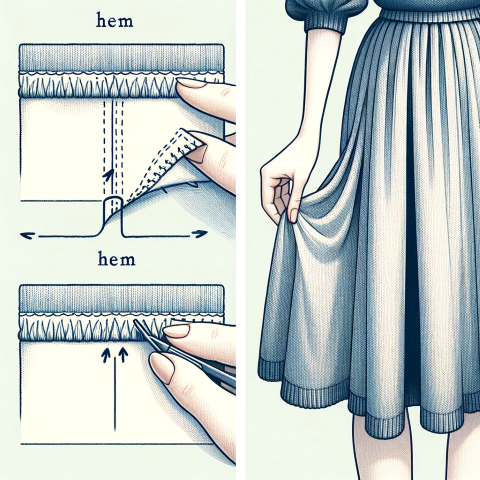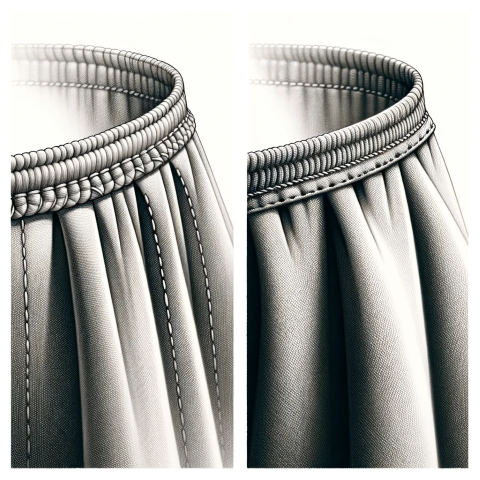What is "Hem" - Definition & Explanation
Last Updated on: 15-Mar-2023 (1 year, 1 month, 8 days ago)
Share on Facebook • Share on Twitter
Last Updated on: 15-Mar-2023 (1 year, 1 month, 8 days ago)
Share on Facebook • Share on Twitter
Hem
In the realm of textiles, a hem refers to the finished edge of a piece of fabric that is folded over and sewn to prevent fraying and provide a neat appearance. It is one of the essential elements in garment construction and is used in various applications, ranging from clothing to household textiles. The process of hemming involves folding the raw edge of the fabric inward, securing it with stitches, and creating a smooth, clean finish.
The primary purpose of a hem is to prevent the fabric from unraveling and fraying, thereby extending the lifespan of the garment or textile. It adds durability to the edges, ensuring they withstand repeated use and washing. Additionally, hems contribute to the overall aesthetic appeal of the textile product by providing a polished and professional look.
Hemming techniques can vary depending on the type of fabric, desired finish, and the purpose of the textile item. There are several common methods used to create hems:
Single Fold Hem: This is the most basic type of hem, where the raw edge of the fabric is folded over once and stitched down. It is often used for lightweight fabrics or as a preliminary step before applying more complex hemming techniques.
Double Fold Hem: In this method, the raw edge is folded over twice, creating a neat and enclosed hem. The double fold provides extra strength and a clean finish. Double fold hems are commonly used in clothing construction, especially for medium to heavyweight fabrics.
Blind Hem: A blind hem is a virtually invisible hem used on garments where the seam is not intended to be visible from the outside. It involves using special stitching techniques that catch only a few threads of the fabric, creating a discreet finish.
Rolled Hem: A rolled hem is a delicate and decorative hemming technique often used for lightweight and sheer fabrics. It involves rolling the raw edge tightly and stitching it close to the folded edge, creating a narrow, elegant finish.
Hems find applications in various textile products such as garments, curtains, tablecloths, napkins, and bed linens. They can be found on the bottom edges of skirts, dresses, and trousers, as well as the sleeves and neckline of garments. Hems provide structure to curtains, allowing them to hang neatly, and give a finished look to tablecloths and napkins.
Several textile manufacturers and users are renowned for their expertise in creating high-quality hems. While it is challenging to highlight all the top users or manufacturers, here are a few notable ones:
Fashion Brands and Designers: Prominent fashion brands and designers prioritize quality finishes and pay significant attention to hems. They often employ skilled artisans and seamstresses who specialize in creating impeccable hems, contributing to the brand's reputation for craftsmanship and attention to detail.
Tailoring and Alteration Services: Tailors and alteration services play a vital role in hemming garments to fit individual clients. These professionals have in-depth knowledge of various hemming techniques and use their expertise to ensure the perfect fit and finish.
Home Textile Manufacturers: Companies specializing in home textiles, such as curtains, bed linens, and tablecloths, incorporate hems to enhance the appearance and functionality of their products. These manufacturers often employ skilled seamstresses who meticulously craft hems to meet the demands of both aesthetics and durability.
Industrial Textile Manufacturers: Industrial textile manufacturers produce a wide range of textiles used in various applications, such as automotive interiors, upholstery, and medical textiles. Hems are often incorporated into these products to provide strength and durability, ensuring they withstand rigorous use in demanding environments.
In summary, hems are an integral part of textile construction, providing a polished finish while preventing fraying and extending the lifespan of textile products. They are utilized in a wide range of applications, from garments to home textiles and industrial products. Skilled artisans, fashion brands, tailoring services, and textile manufacturers all contribute to the utilization and advancement of hemming techniques in the textile industry.
The primary purpose of a hem is to prevent the fabric from unraveling and fraying, thereby extending the lifespan of the garment or textile. It adds durability to the edges, ensuring they withstand repeated use and washing. Additionally, hems contribute to the overall aesthetic appeal of the textile product by providing a polished and professional look.
Hemming techniques can vary depending on the type of fabric, desired finish, and the purpose of the textile item. There are several common methods used to create hems:
Single Fold Hem: This is the most basic type of hem, where the raw edge of the fabric is folded over once and stitched down. It is often used for lightweight fabrics or as a preliminary step before applying more complex hemming techniques.
Double Fold Hem: In this method, the raw edge is folded over twice, creating a neat and enclosed hem. The double fold provides extra strength and a clean finish. Double fold hems are commonly used in clothing construction, especially for medium to heavyweight fabrics.
Blind Hem: A blind hem is a virtually invisible hem used on garments where the seam is not intended to be visible from the outside. It involves using special stitching techniques that catch only a few threads of the fabric, creating a discreet finish.
Rolled Hem: A rolled hem is a delicate and decorative hemming technique often used for lightweight and sheer fabrics. It involves rolling the raw edge tightly and stitching it close to the folded edge, creating a narrow, elegant finish.
Hems find applications in various textile products such as garments, curtains, tablecloths, napkins, and bed linens. They can be found on the bottom edges of skirts, dresses, and trousers, as well as the sleeves and neckline of garments. Hems provide structure to curtains, allowing them to hang neatly, and give a finished look to tablecloths and napkins.
Several textile manufacturers and users are renowned for their expertise in creating high-quality hems. While it is challenging to highlight all the top users or manufacturers, here are a few notable ones:
Fashion Brands and Designers: Prominent fashion brands and designers prioritize quality finishes and pay significant attention to hems. They often employ skilled artisans and seamstresses who specialize in creating impeccable hems, contributing to the brand's reputation for craftsmanship and attention to detail.
Tailoring and Alteration Services: Tailors and alteration services play a vital role in hemming garments to fit individual clients. These professionals have in-depth knowledge of various hemming techniques and use their expertise to ensure the perfect fit and finish.
Home Textile Manufacturers: Companies specializing in home textiles, such as curtains, bed linens, and tablecloths, incorporate hems to enhance the appearance and functionality of their products. These manufacturers often employ skilled seamstresses who meticulously craft hems to meet the demands of both aesthetics and durability.
Industrial Textile Manufacturers: Industrial textile manufacturers produce a wide range of textiles used in various applications, such as automotive interiors, upholstery, and medical textiles. Hems are often incorporated into these products to provide strength and durability, ensuring they withstand rigorous use in demanding environments.
In summary, hems are an integral part of textile construction, providing a polished finish while preventing fraying and extending the lifespan of textile products. They are utilized in a wide range of applications, from garments to home textiles and industrial products. Skilled artisans, fashion brands, tailoring services, and textile manufacturers all contribute to the utilization and advancement of hemming techniques in the textile industry.
Hem
�To hem a piece of cloth (in sewing), a garment worker folds up a cut edge, folds it up again, and then sews it down. The process of hemming thus completely encloses the cut edge in cloth, so that it cannot ravel. A hem is also the edge of cloth hemmed in this manner.
�To hem a piece of cloth (in sewing), a garment worker folds up a cut edge, folds it up again, and then sews it down. The process of hemming thus completely encloses the cut edge in cloth, so that it cannot ravel. A hem is also the edge of cloth hemmed in this manner.
Hem
�The place or act of making a finished edge in fabric by turning under the raw (cut) edge and sewing it.
�The place or act of making a finished edge in fabric by turning under the raw (cut) edge and sewing it.
Hem
�(clean) - The double fold of fabric secured with a row of stitching with the raw edge of the fabric buried within the fold.
�(clean) - The double fold of fabric secured with a row of stitching with the raw edge of the fabric buried within the fold.
Hem
(raw) - A single fold of fabric secured with a row of stitching, leaving the raw edge of the fabric exposed.
(raw) - A single fold of fabric secured with a row of stitching, leaving the raw edge of the fabric exposed.
Hem
A hem is also the edge of cloth hemmed in this manner.
A hem is also the edge of cloth hemmed in this manner.
Hem
�To hem a piece of cloth (in sewing), a garment workerfolds up a cut edge, folds it up again, and then sews it down. The process of hemming thus completely encloses the cut edge in cloth, so that it cannot ravel.
�To hem a piece of cloth (in sewing), a garment workerfolds up a cut edge, folds it up again, and then sews it down. The process of hemming thus completely encloses the cut edge in cloth, so that it cannot ravel.
Hem
Hem the edge of a piece of cloth, such as the bottom edge of a skirt or dress, which is folded over and sewn so that it does not develop loose threads.
Hem the edge of a piece of cloth, such as the bottom edge of a skirt or dress, which is folded over and sewn so that it does not develop loose threads.
Some other terms
Some more terms:
SPF
42
(Sun Protection Factor) SPF measures the effectiveness of sunscreen on the body. the test for SPF is done by using a living organism or body to measure the length of time it takes for the skin to...
Camel Hair
52
Wool-like underhair of the Bactrian camel, a two-humped pack-carrying species that is lustrous and extremely soft. Because it is expensive, often used in blends with wool for coats, suits, sweaters,...
Sunn
85
A bast fiber obtained from the Crotalaria juncea plant. The fibers grow from 4 to 5 feet long and are retted and prepared like other bast fibers. Sunn contains over 80% cellulose and is highly...
Parkas
59
An anorak or parka is a type of heavy jacket with a hood, generally lined with fur or fun fur, so as to protect the face from a combination of sub-zero temperatures and wind. Although of Inuit...
Mull
496
In textile terminology, "mull" refers to a lightweight, sheer fabric that is usually made from cotton or cotton blends. It is known for its soft and delicate nature, making it a popular choice for a...
Add a definition
Add a definition for a textile term that you know about! Send us an email & tell us:
- The term you want to define
- Its definition in 500 words or less
- Attach an image if necessary.
- Optionally, tell us about yourself in 200 words or less!
Companies for Hem:
If you manufacture, distribute or otherwise deal in Hem, please fill your company details below so that we can list your company for FREE! Send us the following details:
- Company name
- Company address
- Attach a logo, if necessary.
- Optionally, tell us about yourself in 200 words or less!
(s) 2024 TextileGlossary.com Some rights reserved. • Sitemap

